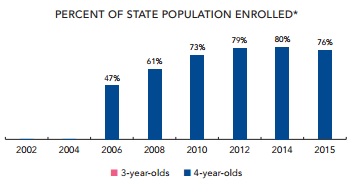In the 10 years since Florida began its massive publicly funded preschool program, the numbers have told an often-overlooked story of steadily expanding access.
That story doesn’t figure prominently in the annual “State of Preschool” reports, the latest of which was released on Thursday.
During the 2005-06 school year, the first in which Voluntary Prekindergarten was available, it served just under half of all four-year-olds in the state. In each subsequent year, participation grew or held steady. Now, only Vermont and the District of Columbia enroll a larger share of their four-year-olds in similar programs.

Florida’s access ranking remains no. 3 (and no. 2 among states) in the latest national report, but for the first time ever, participation appears to have slipped. It’s down to nearly 76 percent of four-year-olds, from 80 percent a year earlier, according to calculations by the National Institute for Early Education Research.
The numbers released by state legislative economists in their January enrollment forecasts are slightly different, but tell the same story: The 2014-15 school year was the first in which the percentage of four-year-olds enrolled in VPK actually declined.
What’s going on here? It’s hard to say for sure. Participation in recent years had been largely flat, hovering around 80 percent. The biggest recent jumps came around 2010, when the state’s economy was in a free-fall. Perhaps more parents have begun paying for preschool on their own.
But it may also be worth noting that per-student funding for VPK remains below pre-recession levels (K-12 public-school funding, on the other hand, has been restored). When it comes to funding, Florida ranks 38 among states.
Florida’s VPK program, created to comply with a state constitutional amendment approved by voters in 2002, prioritizes access over per-student funding. National preschool participation has been largely flat, at 29 percent; the Sunshine State provides publicly funded preschool to four-year-olds at more than two and half times that rate.
To put things in perspective, W. Steven Barnett, the director of the institute that releases the annual preschool reports, laments that at the current rate of growth, “it will take 150 years to reach 75 percent of all four-year-olds” nationally. Florida went from zero to more than 75 percent in less than a decade.
That means more child care for hundreds of thousands of families. It means an academic head start than these four-year-olds would otherwise receive. Serving more than 160,000 students, and a substantial majority of them through private providers, Voluntary Pre-K remains one of Florida’s most widely used and broadly popular educational choice programs.
Over the next ten years it’ll be worth watching whether the state starts increasing per-pupil funding, whether that helps providers improve their quality, and if the state can find a reliable way to measure how well its spending achieves the thing that matters most in early learning programs: Preparing youngsters for kindergarten, something the State of Preschool report doesn’t really examine.


